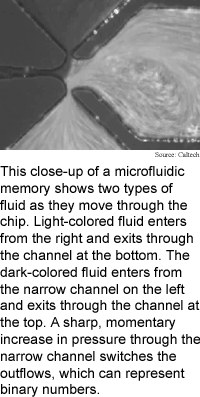
Microfluidics go nonlinear
Researchers from the California Institute
of Technology and the University of California at San Diego have constructed
computer-logic-like circuits that control the flow of fluid through a chamber
rather than the flow of electricity through a solid.
The microfluidic circuits could eventually be used to deliver constant
flows of medicine to specific points in the human body and to control other
microfluidic devices.
The key to the circuit-like behavior is an elastic polymer fluid
that has non-linear properties similar to those of electronics components.
In a linear system the output is proportional to the input; nonlinear output,
however, increases or decreases at a different rate than the input.
The fluid circuits have different-shaped channels that cause the
molecules of the elastic fluid to align or scramble, changing the fluid's
viscosity and therefore its flow rate.
The researchers have constructed a pair of prototype devices. One
produces a constant flow despite changes in fluid pressure. The second switches
between two output channels without using valves. The output channels can
represent a 1 and a 0, respectively, and a string of the devices can store
the binary numbers used in computing.
The work appeared in the May 9, 2003 issue of Science.
Shock waves tune light
Artful displays track data
Plastic transistors go vertical
Artificial beings evolve realistically
News briefs:
Microfluidics go nonlinear
Browser boosts brain interface
Semiconductor emits telecom light
3D display widens view
Study shows DNA will fill tubes
DNA part makes transistor

Research Watch blog
View from the High Ground Q&A
How It Works
RSS Feeds:
News
Ad links:
Buy an ad link
Ad links: Clear History
Buy an ad link
|
TRN
Newswire and Headline Feeds for Web sites
|
© Copyright Technology Research News, LLC 2000-2010. All rights reserved.